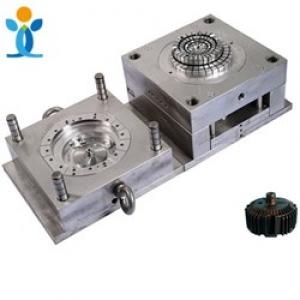Characteristics of LSR liquid silica gel injection
Characteristics of LSR ( liquid silica gel) injection
Generally speaking, the structure of thermosetting liquid silicone rubber (LSR) injection mold is similar to that of thermoplastic compound, but there are also many significant differences. For example, LSR compound generally has low viscosity, so the mold filling time is very short, even at very low injection pressure. In order to avoid air retention, it is very important to set a good exhaust device in the mold.
In addition, LSR compound will not shrink like thermoplastic compound in the mold. They often expand in case of heat and shrink slightly in case of cold. Therefore, the products do not always stay on the convex surface of the die as expected, but stay in the die cavity with large surface area.
1 shrinkage
Although LSRs do not shrink in the mold, they often shrink by 2.5% - 3% after demoulding and cooling. As for the shrinkage, it depends on the formula of the compound to a certain extent. However, from the point of view of the mold, the shrinkage may be affected by several factors, including the temperature of the mold, the temperature when the rubber is demoulded, the pressure in the mold cavity and the subsequent compression of the rubber.
The location of the injection point is also worth considering, because the shrinkage in the flow direction of the compound is usually larger than that in the direction perpendicular to the flow direction of the compound. The overall dimension of the product also has an impact on its shrinkage. The shrinkage of thicker products is generally smaller than that of thinner products. If secondary vulcanization is required, additional shrinkage of 0.5% - 0.7% may occur.
2 parting line
Determining the position of parting line is one of the first steps in the design of silicone rubber injection mold. The exhaust is mainly realized through the groove on the parting line, which must be in the last area of the injected rubber. This helps to avoid internal bubbles and reduce the strength loss at the bonding.
Due to the low viscosity of LSR, the parting line must be accurate to avoid glue overflow. Even so, parting lines can often be seen on shaped products. Demoulding is affected by the geometric dimension of the product and the position of the parting surface. The product is designed with a slight chamfer, which helps to ensure that the product has a consistent affinity for the other half of the mold cavity.
3 exhaust
With the injection of LSR, the air trapped in the mold cavity is compressed when the mold is closed, and then discharged through the vent groove with the mold filling process. If the air cannot be completely discharged, it will stay in the rubber (which will often expose the white edge of the product). The general width of ventilation groove is lmm-3mm and the depth is 0.004mm-0.005mm.
Vacuumizing in the mold can create the best exhaust effect. This is achieved by designing a washer on the parting line and quickly vacuumizing all die cavities with a vacuum pump. Once the vacuum reaches the rated level, the die is completely closed and pressure injection begins.
Some injection molding equipment is allowed to operate under variable closing force, which enables the processor to close the mold under low pressure until 90% - 95% of the mold cavity is filled with LSR (making it easier for air to be discharged), and then switch to a higher closing force to avoid silicone rubber expansion and glue overflow.
4 injection point
Cold runner system is used for molding LSR. It can maximize the advantages of this compound and improve the production efficiency to the maximum. In such a way to process products, it is not necessary to remove the glue injection channel, so as to avoid increasing the labor intensity of the operation and sometimes avoiding a large waste of materials. In many cases, the non injection channel structure can also shorten the operation time.
The rubber injection nozzle is controlled by the needle valve for forward flow. At present, many manufacturers can provide the injection nozzle with pneumatic switch as standard equipment and can set it in various parts of the mold. Some mold manufacturers have specially developed an open cold runner system, which is so small that multiple injection points are set in an extremely limited mold space (and then fill the whole mold cavity). This technology makes it possible to produce high-quality silicone rubber products in large quantities without separating the rubber injection port.
If a cold runner system is used, it is important to form an effective temperature interval between the hot cavity and the cold runner. If the runner is too hot, the compound may begin vulcanization before injection. However, if it is cooled too quickly, it will absorb too much heat from the gate area of the mold, resulting in incomplete vulcanization.
For products injected with conventional sprue (such as submerged sprue and conical sprue), it is suitable to use small-diameter glue injection port for feeding (the diameter of feeding port is usually 0.2mm-0.5mm). LSR compound with low viscosity, like thermoplastic compound, balancing the runner system is very important. Only in this way, all die cavities will be filled evenly by the compound. Using the simulation software to design the runner system can greatly simplify the development process of the die, and its effectiveness is proved by the filling test.
picture
5 demoulding
The vulcanized liquid silicone rubber is easy to adhere to the metal surface, and the flexibility of the product will make it difficult to demould. The high temperature tear strength of LSR can make it demould under general conditions, and even larger products will not be damaged. The most common demoulding technologies include template demoulding, demoulding pin demoulding and pneumatic demoulding. Other common technologies include roller scraping, lead-out plate demoulding and automatic die control.
When using the demoulding system, it must be kept in a high precision range. If the clearance between the ejector pin and the guide pin sleeve is too large, or the clearance of the parts becomes larger due to long-term wear, it may cause glue overflow. The effect of inverted conical or mushroom top selling is very good, because it allows the use of large contact pressure to improve the sealing effect.
6 mold material
The die support plate is usually made of non alloy tool steel (no.1.1730, DIN code c45w). For the die support plate that needs to withstand the high temperature of 170 ℃ - 210 ℃, considering the impact resistance, it should be made of pre tempered steel (no.1.2312, DIN code 40 crmn-m OS 8 6). The mold support plate with mold cavity shall be made of b-steel after nitriding or annealing heat treatment to ensure its high temperature resistance.
For LSR with high filling volume, such as oil resistant LSR, it is recommended to use materials with higher hardness to manufacture molds, such as bright chromium plated steel or powder metal specially developed for this purpose (no.1.2379, dincode x 155 crvmo121). When designing the mold of high wear materials, the parts bearing high friction should be designed to be replaceable, so that the whole mold does not need to be replaced.
The surface in the mold cavity has a great influence on the finish of the product. The most obvious is that the shaped product will completely coincide with the surface of the mold cavity. Molds for transparent products shall be made of polished steel. The surface treated Qin / nickel steel has high wear resistance, while polytetrafluoroethylene (PTFE) / nickel can make demoulding easier.
7 temperature control
Generally speaking, the molding of LSR should adopt electric heating mode, which is usually heated by belt electric heater, cylindrical heater or heating plate. The key is to make the temperature field of the whole die evenly distributed to promote the uniform curing of LSR. It is an economical and effective heating method for large molds when the oil temperature is controlled.
The heat loss can be reduced by covering the die with insulating plate. The unsuitable position of any part of the hot mold may cause it to suffer large temperature fluctuation between various operating procedures or cause air leakage. If the surface temperature drops too low, the curing speed of the compound will slow down, which often makes the product unable to demould and causes quality problems. A certain distance shall be kept between the heater and the parting line to prevent the formwork from warping and deformation and the formation of glue overflow burrs on the finished product.
If the mold of the cold runner system is designed, a complete separation must be ensured between the hot end and the cold end. It can be made of special Qin alloy (such as 3.7165 [tia16v4]) because its thermal conductivity is much lower than other steels. For an integral mold heating system, the heat shield shall be set between the mold and the mold support plate to minimize heat loss.
Proper design and conception can ensure LSR injection molding, which is very important in this mold. The above mold design principles aim to fill the mold cavity with rubber, shorten the curing time, improve the quality of finished products and high output, so as to enable silicone rubber processors to obtain good economic benefits.



